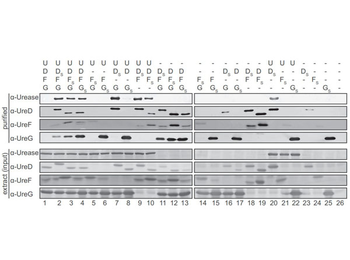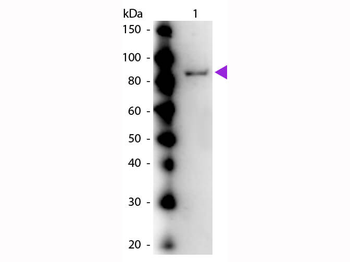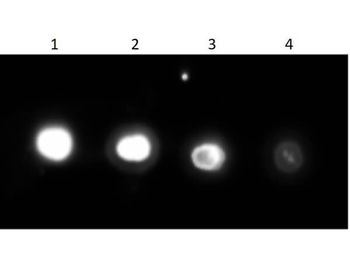You have no items in your shopping cart.
Anti-Urease Antibody
Catalog Number: orb750599
| Catalog Number | orb750599 |
|---|---|
| Category | Antibodies |
| Description | UREA_CANEN antibody |
| Species/Host | Rabbit |
| Clonality | Polyclonal |
| Tested applications | ELISA, IP, WB |
| Reactivity | Plant |
| Isotype | Antiserum |
| Immunogen | Urease [Jack Bean] |
| Antibody Type | Primary Antibody |
| Concentration | 90 mg/mL |
| Dilution range | ELISA: 1:5,000 - 1:20,000, IP: 1:100, WB: 1:500 - 1:5,000 |
| Form/Appearance | Lyophilized |
| Purity | Anti-Urease (Jack Bean) (Rabbit) Antibody was prepared from monospecific antiserum by a delipidation and defibrination. Assay by immunoelectrophoresis resulted in a single precipitin arc against anti-rabbit serum, purified and partially purified Urease [Jack Bean]. Cross reactivity against Urease from other tissues and species may occur but have not been specifically determined. |
| Conjugation | Unconjugated |
| UniProt ID | P07374 |
| NCBI | AAA83831.1 |
| Storage | Store vial at 4° C prior to restoration. For extended storage aliquot contents and freeze at -20° C or below. Avoid cycles of freezing and thawing. Centrifuge product if not completely clear after standing at room temperature. This product is stable for several weeks at 4° C as an undiluted liquid. Dilute only prior to immediate use. |
| Buffer/Preservatives | 0.01% (w/v) Sodium Azide |
| Alternative names | rabbit anti-Anti-Urease Antibody, Urease, Urea ami Read more... |
| Note | For research use only |
| Application notes | Anti-Urease Antibody has been assayed against 1.0 ug of Urease [Jack Bean] in a standard ELISA using Peroxidase conjugated Affinity Purified anti-Rabbit IgG [H&L] (Goat) code #611-1302 and (ABTS (2,2’-azino-bis-[3-ethylbenthiazoline-6-sulfonic acid]) code # ABTS-100 as a substrate for 30 minutes at room temperature. A working dilution of 1:1,000 to 1:3,000 of the reconstitution concentration is suggested for Anti-Urease Antibody. |
| Expiration Date | 12 months from date of receipt. |

Western Blot results using Anti-Urease (Jack Bean) (RABBIT) Antibody. Functional test of rice urease and UAPs expressed in N. benthamiana. A, Western blot loaded with 40 µg of protein (prot.) per lane and probed with anti-urease antibody (top) and urease activity quantification (bottom) using leaf extracts from N. benthamiana after 5 d of transient coexpression of different combinations of OsUrease, OsUreD, OsUreF, OsUreG (lanes I–V) and Atallantoinase (lane VI) as a control. Uninfected leaves were used as an additional control (lane VII). Each urease activity was quantified using three independent leaves from different plants (n = 3). Error bars indicate sd. As indicated by lowercase letters, only activity I is different from all others with statistical significance (P < 0.01). B, Western blot and urease activity as in A from leaves coexpressing either OsUrease, OsUreD, OsUreF, OsUreG (gray columns) or OsUrease, OsUreD, OsUreG, but not OsUreF (black columns). Activities were assessed in a time course from 3 to 6 d after infiltration of the plants with Agrobacterium. Error bars indicate sd (n = 3 independent leaves).

Western Blot results using Anti-Urease (Jack Bean) (RABBIT) Antibody. Protein interactions of A. thaliana UAPs and urease. Urease (U) and the accessory proteins UreD, UreF, and UreG (D, F, and G) were co-expressed in leaves of N. benthamiana as indicated. N-terminally Strep-tagged variants of the UAPs (the respective tagged protein is labeled with S) and its interaction partners were affinity-purified from extracts and detected on Western blots. Lower panel, clarified leaf extracts (input). Upper panel, after affinity purification. The experiment was repeated three times, and a representative repeat is shown.





